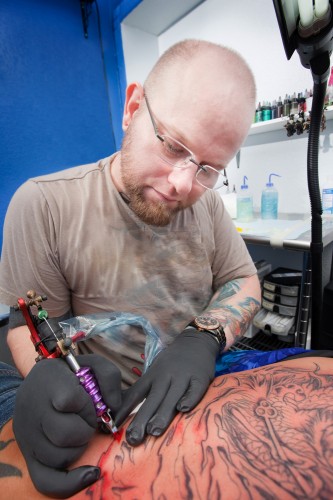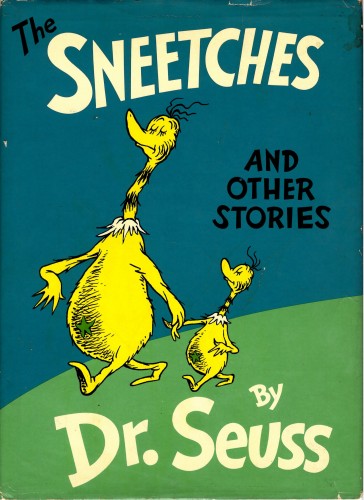Tattoos, sin and Sneetches
 The Life Style section of the Washington Post has an interesting and well crafted story entitled "Rethinking the ink: Laser Tattoo removal gains popularity," that reports on the flourishing tattoo removal industry. It discusses the current rage for tattoos among the American middle classes. What sets this story apart are the vignettes from those undergoing the painful and expensive procedure to have their body art removed. And alongside stories of buyer's remorse and shifting style we hear snippets of faith. The article does a nice job incorporating them into the narrative. But it stops short. We hear the language of faith, but no explanation as to why faith matters.
The Life Style section of the Washington Post has an interesting and well crafted story entitled "Rethinking the ink: Laser Tattoo removal gains popularity," that reports on the flourishing tattoo removal industry. It discusses the current rage for tattoos among the American middle classes. What sets this story apart are the vignettes from those undergoing the painful and expensive procedure to have their body art removed. And alongside stories of buyer's remorse and shifting style we hear snippets of faith. The article does a nice job incorporating them into the narrative. But it stops short. We hear the language of faith, but no explanation as to why faith matters.
The article opens nicely. The first sentence is ambiguous, a teaser of sorts. In the second sentence the topic of tattoo removal is offered. In the third we have a confession and the fourth offers the Post's editorial voice.
She arrives quietly, coming in from the rain after work. She lies down on her stomach atop a sleek, white reclining chair. She lifts her shirt and tugs down her jeans slightly.
It’s enough to unveil a large pink flower tattoo with fat, webby green leaves, which she’s here to have lasered off her lower back. She wants to become a mother someday, and she doesn’t want her children to see this. The process could take up to 10 sessions, she says. She pauses. Then she starts crying.
“I was only 18. It was a homemade tattoo done at a party,” says Lizeth Pleitez, 30, who quickly dries her eyes. Her voice is shaking. “I wasn’t thinking about what it meant, you know? Little did I know it meant something else — like people calling it a ‘tramp stamp.’ I’m a Pentecostal, and the body is a temple. And I felt really ashamed.”
If tattoos are the marks of an era — declarations of love, of loss, of triumph, of youthful exuberance or youthful foolishness — then tattoo removals are about regret, confessions that those landmarks are in the past. They’re about the realization that whatever you believed in with such force that you wanted it eternally branded on your skin is now foreign to you.
The article offers a discussion of the tattoo removal industry, focusing on two Washington DC area firms and then moves back to first person narratives that do a fine job of illustrating the theme of the story. The thesis of the article comes with this line:
Part of what made tattooing cool was its outlaw vibe: the Harley biker, the heavy-metal drummer, the ex-con. Part of what makes tattooing uncool is its ubiquity. Newman recently went to Rehoboth Beach, Del., for the weekend, and “every Tom, Dick and Harry had a tattoo, and it looked ridiculous. I started the removal sessions right after that.”
There are strong religious overtones to several of the confessions.
Then the burly, tattoo-faced Wayne Stokes, 34, arrives. He’s on his sixth session of a removal that might take up to 25.
He has tattoos on his face, neck, hands and chest. Both eyes are encircled by a black leopardlike Maori-inspired design, which is based on the tattoo sported by boxer Mike Tyson. The tops of his hands spell out S-U-F-F-E-R-I-N-G when he holds them side by side. The left side of his neck says “Life,” the back of his neck says “Is,” and the right side says “Pain.”
He started getting tattoos when he was 16. He says he grew up in rough neighborhoods in Baltimore, suffered abuse at the hands of his father and was threatened outside his home, too: by drugs, by peers on the streets.
“Subconsciously I was creating an image to keep people at bay and away from me. I wanted to look tough,” he says. “People ask me every day, ‘Why did you do it? Why did you put yourself through that pain of tattooing your entire face?’ I’ve realized I don’t have to keep that trauma on my body.”
He’s gone through a lot of therapy. He works as a cook, but when the tattoos are off, he wants to mentor abused kids.
Now that the painful decision to get rid of the tattoos is over, the physical pain begins. He prays in the bathroom for strength. He gets into the chair and squeezes a ball as the laser hits his skin, turning parts of it red and then frosted white as the ink crystallizes into smaller particles that will be removed by his body’s immune system over the next few weeks. The laser emits a green light, and the room smells a little bit like burned hair. “I want to look in the mirror and see myself again.”
 While characters in this story from first to last couch their thoughts in religous terms, the article declines to go deeper. It appears comfortable speculating about the vagaries of style but is shy of belief. The style argument is cleverly made by reference to the Dr. Seuss' The Sneetches.
While characters in this story from first to last couch their thoughts in religous terms, the article declines to go deeper. It appears comfortable speculating about the vagaries of style but is shy of belief. The style argument is cleverly made by reference to the Dr. Seuss' The Sneetches.
“Belly stars are no longer in style”, said McBean.
“What you need is a trip through my Star-Off Machine. This wondrous contraption will take OFF your stars so you won’t look like Sneetches that have them on thars.” And that handy machine working very precisely Removed all the stars from their tummies quite nicely.
Then, with snoots in the air, they paraded about. And they opened their beaks and they let out a shout, “We know who is who! Now there Isn’t a doubt. The best kind of Sneetches are Sneetches without!”
But while Dr. Seuss used his tale as a cautionary word against prejudice, the Post plays upon the fantastical tattoo on / tattoo off business of Sylvester McMonkey McBean. However the wit and insight brought to the question of style is lacking on the faith issues. When the young woman who identifies herself as a Pentecostal states "the body is a temple" there is no explanation that she is referring to the Bible.
The Apostle Paul argued that our bodies are not ours to do with or defile as we please. Do you not know that your body is a temple of the Holy Spirit, who is in you, whom you have received from God? You are not your own; you were bought at a price. Therefore honor God with your body. (1 Cor 6:19-21)
Her words and tears may mean that she believes that by having a tattoo she has defiled her body. Her tattoo is a sign of her sin. The man who is having his face tattoos removed states he prays for strength before the procedures. The tattoos may have been his flight from reality and from God. By removing them he will be cleansed and "see myself again."
There is not a strict prohibition on tattooing in Christianity, but it is discouraged in some quarters. The Old Testament forbids tattooing. You shall not make any cuttings in your flesh for the dead, neither shall you tattoo any marks upon you: I am the LORD. (Leviticus 19:28)
Orthodox Judaism thus prohibits tattooing. The injunction is so explicit that it has not been softened in the halakhic literature. A tattoo for a Jew is tantamount to rejecting orthodoxy -- and was part of the dehumanization the Nazis inflicted upon the Jews at Auschwitz.
For Sunni Muslims, tattooing is haram -- forbidden. The Hadith of Sahih al-Bukhari states: May Allah curse the women who do tattoos and those for whom tattoos are done, those who pluck their eyebrows and those who file their teeth for the purpose of beautification and alter the creation of Allah. (al-Bukhari, al-Libaas, 5587; Muslim, al-Libaas, 5538), while The Prophet cursed the one who does tattoos, the one who has a tattoo done, the one who consumes riba (usury or interest) and the one who pays it, and he forbade the price of a dog and the earnings of a prostitute, and he cursed the image-makers. (al-Bukhari, 5032).
I offer these passages from the Jewish, Muslim and Christian Scriptures not as some sort of proof texting to establish the proposition that tattooing is a sin, but to demonstrate the topic has strong religious overtones. This is seen by the explicit language used by some of those interviewed by the Post.
The absence of context for the characters' statements leaves this article incomplete and prevents a good article from being great.
Tattooing photo courtesy of Shutterstock.